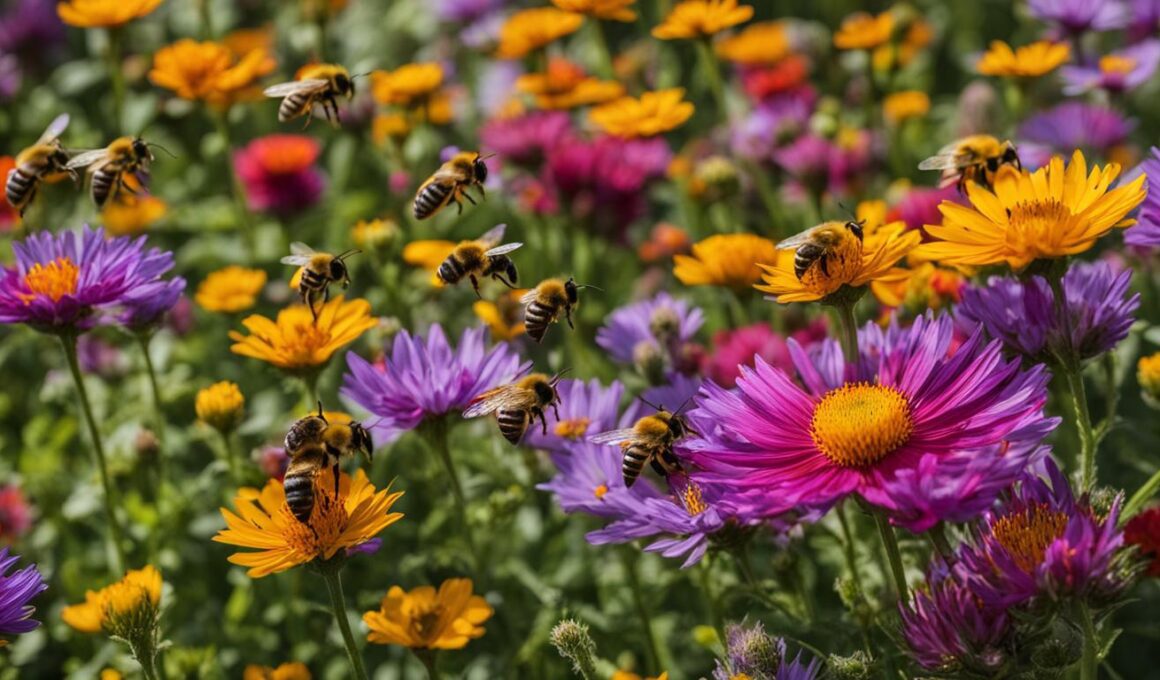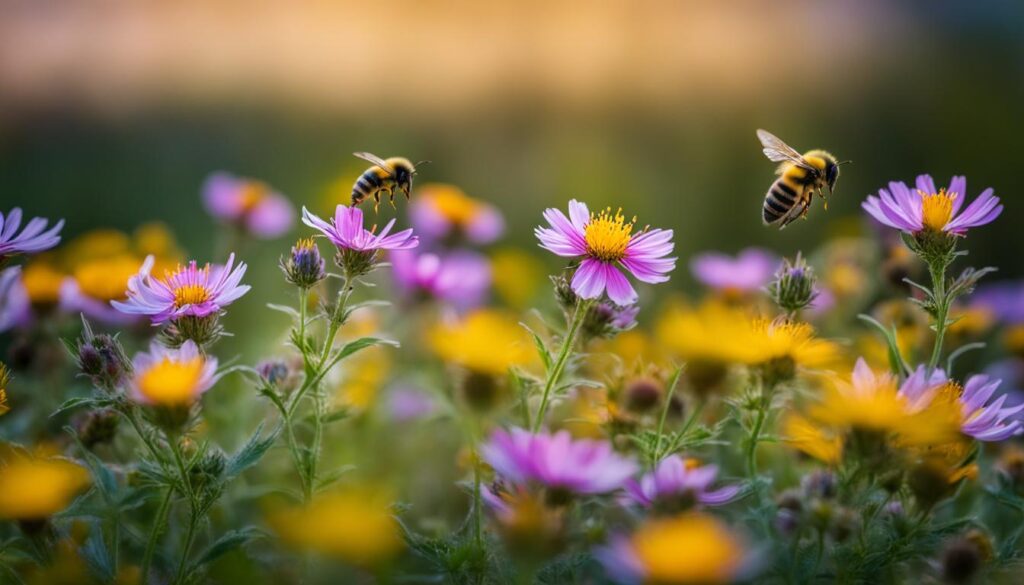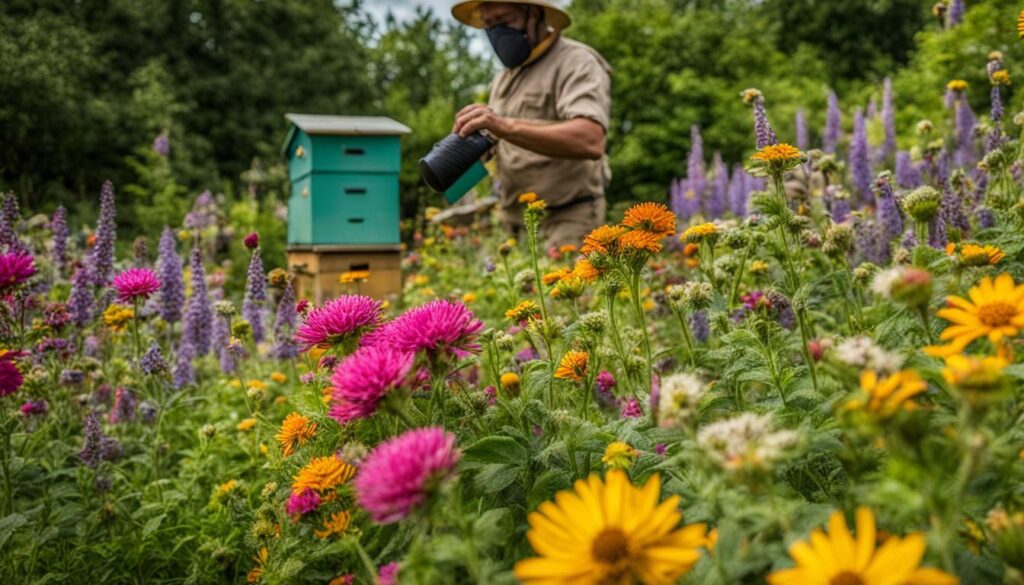If you love spending time in your garden but are worried about getting stung by bees, we have the solution for you! With the right selection of bee repellent flowers, you can create a sting-free oasis in your very own backyard. Not only will this allow you to enjoy your outdoor living areas without fear, but it will also help support and protect the bee populations that are essential for our ecosystem.
By planting bee-beloved flowers like lavender, crocus, hyacinth, and snapdragons at the far edge of your yard, you can attract bees to the nectar-rich blooms while keeping them away from your patio, deck, or pool area. Additionally, creating a “bee bath” with fresh water and avoiding shaded areas will further discourage bees from venturing near your frequently visited spaces.
Key Takeaways:
- Planting bee-beloved flowers at the far edge of your yard can attract bees away from your frequently visited areas.
- Creating a “bee bath” with fresh water provides bees with a water source and further keeps them away from your outdoor living spaces.
- Bumblebees are generally gentle creatures and won’t sting unless they feel threatened.
- It’s important to differentiate between bees and wasps, as wasps can be aggressive and pose a threat in late summer and early fall.
- If you come across a wasp or hornet’s nest, it’s best to contact a licensed pest-control professional for removal.
How Bees and Flowers Are Inseparable in Nature
Bees and flowers have a symbiotic relationship in nature, with flowers relying on bees for pollination and bees relying on flowers for nectar and pollen. Most flowers are designed to be attractive to passing bees, as bees play a crucial role in the reproduction of flowering plants. Bees are responsible for pollinating crops, fruits, and vegetables, making them essential for food production. The process of pollination occurs when bees collect nectar from flowers, inadvertently transferring pollen from one flower to another as they move from bloom to bloom.
This intricate dance between bees and flowers helps to ensure the survival of both species. As bees collect nectar, they unknowingly transfer pollen from the male parts of a flower to the female parts of another, allowing for fertilization and the production of seeds. This process not only affects the reproduction of individual plants but also contributes to the overall biodiversity of ecosystems.
Without the mutualistic relationship between bees and flowers, many plant species would struggle to reproduce and would eventually decline in numbers. In turn, the decline of flowering plants would have a significant impact on other organisms that rely on them for food and habitat. Thus, the inseparability of bees and flowers highlights the intricate interconnectedness of the natural world and the importance of preserving their delicate balance.
The Challenge of Finding Bee-Repellent Flowers
While it may be challenging to find flowers that actively repel bees, there are certain plants that bees are less attracted to. Most flowering plants go to great lengths to make themselves attractive to passing bees, as they rely on bees for pollination. However, some plants, such as wormwood, mint, eucalyptus, and citronella, are reputed to discourage wasps, which can be aggressive and dangerous. Incorporating non-flowering plants like evergreen shrubs and foliage plants, as well as placing flowering plants further away from frequently visited areas, can also help reduce bee activity in specific parts of your garden.
When it comes to choosing plants that deter bees, it’s essential to strike a balance between creating a sting-free environment and supporting bee populations. While deterring bees may be necessary for those with allergies or specific needs, it’s important to remember the vital role bees play in pollination and the health of ecosystems. By incorporating a variety of plants that bees are less attracted to, you can create a harmonious garden that minimizes bee activity in certain areas while still providing a welcoming habitat for these important pollinators.
Plants That Deter Bees
- Wormwood: Known for its strong aroma, wormwood is reputed to repel both bees and wasps. Its silvery foliage adds an interesting texture to the garden.
- Mint: With its cooling scent, mint is a popular herb that can help deter bees. It is best planted in pots or containers to prevent it from spreading too aggressively.
- Eucalyptus: The strong scent of eucalyptus leaves can discourage bees from visiting certain areas of your garden. Consider planting it in strategic locations to help repel bees.
- Citronella: Known for its mosquito-repellent properties, citronella is also said to deter bees. Incorporate citronella plants or candles into your outdoor space for added protection.
Remember, it’s important to choose plants that deter bees responsibly and in moderation. While these plants can help reduce bee activity in specific areas, they are still important for other beneficial insects and wildlife. By considering the needs of both your garden and the bees, you can create a beautiful outdoor space that strikes a harmonious balance between a sting-free environment and supporting bee populations.
Flowering Plants That Bees Are Less Attracted To
When it comes to creating a sting-free garden, it can be challenging to find flowers that actively repel bees. However, there are certain flower colors and types that bees are less attracted to. Bees see most colors from orange to ultraviolet but cannot see infrared or red. This makes flowers with red blooms less attractive to bees, especially those with patterns of alternating colors like red and yellow.
Some examples of red flowers that bees are less attracted to include red lilies, yarrow ‘Paprika’, hummingbird mint (Agastache), red hot poker, cardinal flower, maltese cross, chrysanthemums, and certain rose cultivars. By incorporating these flowers into your garden, you can add vibrant color while minimizing bee activity.
Less Attractive Flowers for Bees:
- Red lilies
- Yarrow ‘Paprika’
- Hummingbird mint (Agastache)
- Red hot poker
- Cardinal flower
- Maltese cross
- Chrysanthemums
- Certain rose cultivars
These flowers not only create an aesthetically pleasing garden but also help to minimize bee activity in specific areas.
Quote:
“Flowers with red blooms are less attractive to bees, especially those with patterns of alternating colors like red and yellow.”
Aromatic Plants That Deter Bees
Bees have a strong sense of smell, and certain plants with powerful aromas can help deter them from specific areas of your garden. These aromatic plants emit scents that bees find unpleasant, prompting them to stay away. By strategically placing these plants in sensitive areas such as patios or pools, you can effectively reduce bee activity and enjoy your outdoor space without the worry of bee stings.
Some aromatic plants that repel bees include:
- Basil: This fragrant herb not only adds flavor to your culinary creations but also has a strong scent that bees find unappealing.
- Geraniums: These colorful flowers with their distinct scent can help keep bees at bay, making them a great addition to bee-repellent gardens.
- Marigolds: Known for their bright blooms, marigolds also emit an odor that deters bees, making them a popular choice for repelling these buzzing insects.
- Artemesia: With its silver-gray foliage and strong aroma, artemesia is an excellent choice for creating a bee-free zone in your garden.
While these aromatic plants can help deter bees, it’s important to remember that they are still valuable for other beneficial insects. Use these plants judiciously and consider their impact on the overall ecosystem. Striking a balance between creating a sting-free environment and supporting biodiversity is key to maintaining a harmonious coexistence with bees.
Cultural Practices to Reduce Bee Populations
When it comes to creating a sting-free garden, incorporating cultural practices can help reduce bee populations in specific areas without harming these important pollinators. Here are some prevention methods for bees that you can implement:
- Remove potential nesting sites: Brush piles, old wood porches, and other secluded areas can attract bees looking for a place to build their nests. By removing these potential nesting sites, you can discourage bee activity in those specific locations.
- Consider alternative ground coverings: Applying mulch or using ground cover plants that are less attractive to bees can help deter them from nesting in certain areas of your garden. Opting for materials like gravel or stepping stones instead of organic mulch can be effective.
- Paint exposed wood surfaces: Bees are attracted to untreated wood surfaces, as they provide ideal nesting spots. To discourage their presence, consider painting exposed wood with a sealant or using alternative materials.
By implementing these cultural practices, you can create an environment that is less conducive to bee nesting and activity. However, it’s important to strike a balance between reducing bee populations and supporting biodiversity. Remember, bees are essential for pollination and the overall health of ecosystems, so it’s crucial to preserve and protect them while maintaining a sting-free garden.
Expert Tip:
When applying mulch or ground coverings, make sure to leave open areas of bare soil for ground-nesting bees. These bees play a vital role in pollinating native plants and should be encouraged in the garden.
By following these cultural practices, you can create a more comfortable outdoor space while still supporting bee populations and ensuring the continuation of vital pollination services.
Avoiding Pesticides and Embracing Environmentally Friendly Practices
When it comes to dealing with bees in your garden, it’s important to prioritize environmentally friendly practices and avoid the use of pesticides. Bees are crucial for pollination and the overall health of ecosystems, so it’s important to find ways to coexist with them rather than resorting to harmful chemicals. By taking a few simple steps, you can create a harmonious environment that promotes the well-being of both your garden and bee populations.
To begin, eliminate the use of pesticides in your garden. Instead, opt for natural pest control methods such as companion planting, which involves strategically placing plants that repel pests alongside your flowers and vegetables. For example, marigolds can deter aphids, a common garden pest, while peppermint can repel ants. These natural alternatives not only protect your plants but also help create a safe and welcoming space for bees.
“Eliminate the use of pesticides in your garden and opt for natural pest control methods such as companion planting.”
Furthermore, consider incorporating bee-friendly practices into your gardening routine. Planting native flowers that provide nectar and pollen for bees is a great way to attract them to your garden while supporting their needs. Additionally, providing a water source, such as a shallow dish filled with fresh water and stones for bees to perch on, can help them stay hydrated.
Living in Harmony with Bees
Living with bees in your garden is not only beneficial for the environment but also offers an opportunity to observe and appreciate these fascinating creatures. By adopting environmentally friendly practices and creating a bee-friendly garden, you can enjoy a thriving and vibrant outdoor space while contributing to the preservation of bee populations.
Conclusion
Creating a sting-free garden while still supporting bee populations is possible by implementing a combination of strategies. Planting bee-beloved flowers like lavender, crocus, hyacinth, and snapdragons at a distance from frequently visited areas can attract bees away from your patio, deck, or pool. Incorporating non-flowering plants and using aromatic plants like basil, geraniums, marigolds, and artemesia can further deter bees naturally. Additionally, practicing cultural methods like removing brush piles and applying mulch or ground coverings can help reduce bee populations in specific locations.
By striking a balance between creating a safe outdoor space and supporting bees, you can enjoy a sting-free garden while minimizing the impact on bee populations. Remember, bees play an essential role in pollination and the overall health of ecosystems, so it’s important to avoid using pesticides that harm them. Instead, embrace environmentally friendly gardening practices, such as planting native flowers and providing water sources, to create a harmonious coexistence with these valuable pollinators.
With these strategies in place, you can have a beautiful and vibrant garden that is both sting-free and beneficial for bees. So, go ahead and create your own bee-friendly oasis, where you can relax and enjoy the beauty of nature while knowing that you are contributing to the well-being of these important insects.
Are Bee-Repellent Flowers Safe for the Environment?
There is some concern about the safety of flowers that bees avoid for the environment. While these flowers may reduce bee presence, they can also disrupt the natural ecosystem and hinder pollination. It’s important to carefully consider the impact of using bee-repellent flowers on the environment.
FAQ
Can I repel bees from my garden?
While it may be challenging to find flowers that actively repel bees, there are certain plants that bees are less attracted to. Incorporating non-flowering plants, placing flowering plants further away from frequently visited areas, and using aromatic plants can help reduce bee activity in specific areas of the garden.
What flowers are less attractive to bees?
Bees are less attracted to flowers with red blooms, especially those with patterns of alternating colors like red and yellow. Some examples include red lilies, yarrow ‘Paprika’, hummingbird mint, red hot poker, cardinal flower, maltese cross, chrysanthemums, and certain rose cultivars.
What plants can deter bees with fragrance?
Aromatic plants like basil, geraniums, marigolds, and artemesia have scents that can repel bees and other insects. These plants can be strategically placed in sensitive areas, such as patios or pools, to reduce bee activity.
How can I reduce bee populations in specific areas?
Certain cultural practices can help, such as removing brush piles, painting wood porches, and applying mulch or ground coverings. These practices can deter bees from nesting in specific locations.
Can I use pesticides to remove bees from my garden?
It’s important to avoid using pesticides to remove bees from the garden or landscape, as bees are essential for pollination and the overall health of ecosystems. Using environmentally friendly practices and accepting the presence of bees can help maintain a balance between enjoying a sting-free garden and supporting bee populations.












